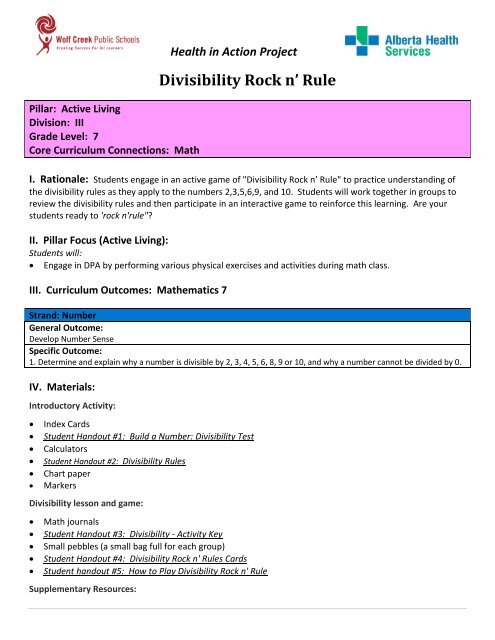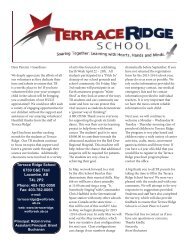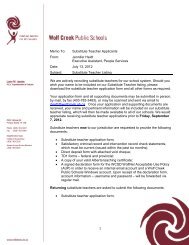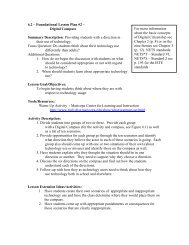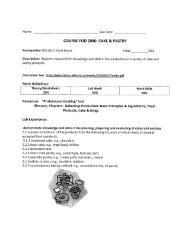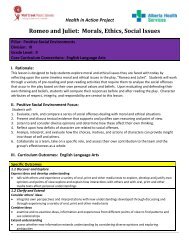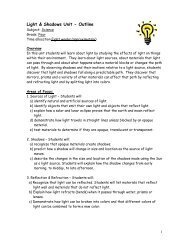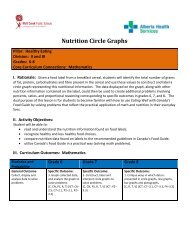Divisibility Rock n' Rules - Wolf Creek Public Schools
Divisibility Rock n' Rules - Wolf Creek Public Schools
Divisibility Rock n' Rules - Wolf Creek Public Schools
Create successful ePaper yourself
Turn your PDF publications into a flip-book with our unique Google optimized e-Paper software.
Pillar: Active Living<br />
Division: III<br />
Grade Level: 7<br />
Core Curriculum Connections: Math<br />
Health in Action Project<br />
<strong>Divisibility</strong> <strong>Rock</strong> n’ Rule<br />
I. Rationale: Students engage in an active game of "<strong>Divisibility</strong> <strong>Rock</strong> n’ Rule" to practice understanding of<br />
the divisibility rules as they apply to the numbers 2,3,5,6,9, and 10. Students will work together in groups to<br />
review the divisibility rules and then participate in an interactive game to reinforce this learning. Are your<br />
students ready to 'rock <strong>n'</strong>rule"<br />
II. Pillar Focus (Active Living):<br />
Students will:<br />
Engage in DPA by performing various physical exercises and activities during math class.<br />
III. Curriculum Outcomes: Mathematics 7<br />
Strand: Number<br />
General Outcome:<br />
Develop Number Sense<br />
Specific Outcome:<br />
1. Determine and explain why a number is divisible by 2, 3, 4, 5, 6, 8, 9 or 10, and why a number cannot be divided by 0.<br />
IV. Materials:<br />
Introductory Activity:<br />
<br />
<br />
<br />
<br />
<br />
<br />
Index Cards<br />
Student Handout #1: Build a Number: <strong>Divisibility</strong> Test<br />
Calculators<br />
Student Handout #2: <strong>Divisibility</strong> <strong>Rules</strong><br />
Chart paper<br />
Markers<br />
<strong>Divisibility</strong> lesson and game:<br />
<br />
<br />
<br />
<br />
<br />
Math journals<br />
Student Handout #3: <strong>Divisibility</strong> - Activity Key<br />
Small pebbles (a small bag full for each group)<br />
Student Handout #4: <strong>Divisibility</strong> <strong>Rock</strong> <strong>n'</strong> <strong>Rules</strong> Cards<br />
Student handout #5: How to Play <strong>Divisibility</strong> <strong>Rock</strong> <strong>n'</strong> Rule<br />
Supplementary Resources:
Web sites:<br />
<br />
<br />
<br />
<br />
Why do the divisibility "rules" work<br />
<strong>Divisibility</strong> <strong>Rules</strong><br />
<strong>Divisibility</strong> Math Tricks to Learn the Facts<br />
HomeschoolMath.net - <strong>Divisibility</strong> <strong>Rules</strong><br />
Teacher Background: The rules of divisibility are simple formulas for understanding how fair shares can be<br />
created from large numbers without practicing long or short division. In grade 7, students have developed a<br />
basic understanding of why numbers are divisible by 2, 5, and 10, but it is important to illustrate the reasons<br />
why. It is helpful to separate the formulas for 2, 5, and 10 (which depend on the digit in the ones column)<br />
from the formulas for 3 and 9 (which depend on the sum of the digits and the formula for 6, which combines<br />
the rules for 2 & 3). Note that there are simple formulas for divisibility by 4, and 8, (as well as more<br />
complicated formulas for larger numbers)<br />
This lesson should be sequenced after division with whole numbers has been reviewed and practiced, division<br />
with remainders has been reviewed and practiced, and students are familiar with vocabulary terms dividend,<br />
divisor, and quotient. It may also be used to review prime and composite, since every number greater than 2<br />
that is divisible by 2, 3, 5, 6, 9, or 10 is composite; also, when discussing divisibility, students will probably<br />
remember that all numbers are divisible by one and themselves.<br />
V. Procedure:<br />
i. Activating Strategies<br />
Introductory Activity:<br />
Divide the class into teams of three and assign each student one of these roles to each student in the group:<br />
director, recorder, and materials coordinator. Provide each team with four index cards and ask them to write<br />
a different digit between 0 and 9 on each card. Using the four different digits only once, each team will then<br />
make a list of all the possible four-digit number combinations being sure to use each digit only once. There will<br />
be 24 possible number combinations. Handout "Build a Number: <strong>Divisibility</strong> Test", with columns for the<br />
numbers they created, plus the columns for 2, 3, 5, 6, 9 and 10 listed across the top. Using calculators if you<br />
wish, have the students divide each of their 24 numbers by 2, 3, 5, 6, 9 and 10 to decide if their numbers<br />
divide evenly without leaving remainders. If the number divides evenly, have the students place a check mark<br />
in the correct column if the number does not divide evenly, have the students place an “x” instead.<br />
After this chart is complete, have each team record their check marked (yes) examples on chart paper hanging<br />
around the room, one piece for each of the numbers 2, 3, 5, 6, 9, and 10. Once this is done, have each team<br />
make a hypothesis about a “rule” for divisibility for each of the numbers 2, 3, 5, 6, 9, and 10. Have them record<br />
their hypotheses on student handout #2 labelled “<strong>Divisibility</strong> <strong>Rules</strong>”. Each student will need their own copy of<br />
the both of these handouts for the next part of the lesson.<br />
ii. Acquiring Strategies:<br />
1. Refer to the chart paper lists and have each group share their hypotheses of divisibility rules for each<br />
number. Discuss student rule predictions, share the correct rules for each number, and then have each<br />
student record them on this graphic organizer for future reference.<br />
2. Draw a Venn Diagram on the board and ask students if it is possible to divide their rules into two main<br />
categories. Guide them in the process of separating their numbers where the ones digit determines the
divisibility (2, 5, 10) from the numbers that require adding all the digits (3, 9). Have them copy this Venn<br />
Diagram in their math notebooks as you complete it together on the board.<br />
3. Remind the students to keep their journals handy to refer the divisibility rules as they play <strong>Divisibility</strong> <strong>Rock</strong><br />
n’ Rule.<br />
iii. Applying Strategies<br />
Game Instructions "<strong>Divisibility</strong> <strong>Rock</strong> n’ Rule" (student handout attached)<br />
1. Divide the class into groups of two to six students per game. (An ideal number of players per game is three<br />
students because each player will always have a job.)<br />
2. Handout out the following materials to each group: a bag of rocks, <strong>Divisibility</strong> Key (student handout #3),<br />
and <strong>Rock</strong> <strong>n'</strong> rules <strong>Divisibility</strong> Cards (student handout #4) to be cut out and then laid face down evenly<br />
among members of a group, and Game instructions (Student handout #5). Discard any remaining cards.<br />
Pile the rocks in the center of the game.<br />
3. As a group, decide upon a particular type of physical exercise or locomotor skill to be assigned to each<br />
number and write the name of the chosen exercise or activity above the its number at the top of each<br />
column. For example, #2 could be “squats”, #3 could be “jumping jacks”, and #5 sit-ups etc.<br />
4. Decide which person will be the first player. The person sitting on the right hand side of the first player will<br />
be the “Rule Master” and hold the <strong>Divisibility</strong> Key and the person on the left will be the Challenger.<br />
5. The first player turns over his or her top card The “Rule Master” asks, “Is it divisible by 2” If the player<br />
answers, “yes,” then he takes a rock from the pile. The process is repeated with the numbers 3, 5, 6, 9, and<br />
10, with the player taking a rock for each “yes” answer. (For example a student should take three rocks for<br />
the number 10 because it is divisible by 2, 5, and 10.)<br />
6. Then the “Rule Master” turns to the Challenger and asks, “Do you want to challenge him” If the Challenger<br />
believes any answers were incorrect, he or she may answer “yes,” telling what numbers are believed to be<br />
incorrect.<br />
7. If the Challenger is right, he gets all the rocks from the player and the player must perform each activity on<br />
the list for the corresponding numbers that were in question. For example, if the player said that a number<br />
was divisible by 7 and it wasn’t and the Challenger challenged that answer and was proven to be correct,<br />
then the player would have to perform the exercise that was assigned to the #7, seven times. If the<br />
Challenger is incorrect, he forfeits the next turn and must perform the exercises that correspond to each of<br />
the numbers that he/she challenged. For example, if the Challenger believes that the number drawn was<br />
not divisible by 3 or 9, and it is proven that the number was in fact divisible by both 3 and 9, then the<br />
Challenger would have to perform the exercises that correspond to 3 and 9 on the <strong>Divisibility</strong> - Activity Key<br />
(doing the 3 exercise, 3 times and the 9 exercise, 9 times).<br />
8. If the player is wrong and the Challenger refuses to challenge, the “Rule Master” corrects the turn and<br />
corrects the number of rocks taken and all players do the exercises that correspond to each number on the<br />
<strong>Divisibility</strong> Key the appropriate number of times.<br />
9. The play then moves clockwise to the left, with the past player becomes the “Rule Master” and is now<br />
responsible for the <strong>Divisibility</strong> Key, and the Challenger becomes the next player.<br />
10. At the end of a round, the person with the most rocks collects the cards used in the round and all the rocks<br />
are returned to the center of the game. A new round is played.<br />
11. At the end of a round, if there is a tie, both players involved in the tie turn over their next card and collect<br />
the rocks for that card. Whoever holds the card that earns the most rocks wins the round.<br />
12. A player is out when he is out of cards; the player with all the cards at the end of the game is the winner.<br />
13. To shorten the game, the teacher may set a time limit; the person with the most cards at the end of the<br />
allocated time is the winner.
VI. Extensions and Variations:<br />
i. Variations:<br />
<br />
<br />
<br />
Challenge advanced learners to discover the rule of divisibility for 4 (last two digits are either 00 or are<br />
divisible by 4), and the rule for 8 (last three digits are divisible by 8). <strong>Rules</strong> for higher numbers are available<br />
on the web sites listed in the additional resources.<br />
Why do the rules work Advanced learners may enjoy hypothesizing about the rules for 3 and 9—why are<br />
adding digits meaningful Explanations are given on the web sites listed in the additional resources.<br />
Multi-level grouping for the introductory activity and game will benefit struggling learners through<br />
cooperative processes.<br />
ii. Extensions:<br />
<br />
<br />
<br />
The scientific method is used to discover mathematical absolutes. Students may recognize science<br />
vocabulary as the rules for divisibility are discovered through the formation of hypotheses, the gathering<br />
of data, the formation of conclusions, etc.<br />
Have students experiment with applying the rule so of divisibility to real-life situations Ask the students to<br />
find at least one example after school where the rules of divisibility shorten the task of creating equal<br />
shares. An example: mom makes 15 muffins. She knows they can be divided evenly among the five people<br />
in her family. Share examples that are discovered with the rest of the class.<br />
Are the rules of divisibility for 3 and 9 unfamiliar enough to mystify people How many people can you<br />
surprise by asking them to tell you a 10-digit number and then you telling them whether it is divisible by 3<br />
and 9 Record their numbers and their comments and report back to class for a discussion<br />
VII. Assessment Ideas:<br />
<br />
<br />
<br />
Pre-assessment: Observe the students' hypotheses as they write on their graphic organizers to see if their<br />
prior knowledge about divisibility is accurate, especially with numbers 2, 5, and 10.<br />
Formative assessment: Check for accuracy as students write correct rules on their graphic organizers,<br />
complete their Venn diagrams, and play "<strong>Divisibility</strong> <strong>Rock</strong> n’ Rule".<br />
Final assessment: Using the <strong>Divisibility</strong> Test graphic organizer as a master, list ten numbers and have the<br />
students complete the chart with “yes” or “no” answers.
Student Handout #1<br />
"Build a Number: <strong>Divisibility</strong> Test"<br />
1. Write the 24 numbers you created in the first column.<br />
2. Decide if the numbers are divisible by 2, 3, 4, 5, 6, 8, 9, or 10. Put a check mark if the number is divisible<br />
and an "x" if it is not divisible in the appropriate column.<br />
Number 2 3 5 6 9 10<br />
1.<br />
2.<br />
3.<br />
4.<br />
5.<br />
6.<br />
7.<br />
8.<br />
9.<br />
10.<br />
11.<br />
12.<br />
13.<br />
14.<br />
15.<br />
16.<br />
17.<br />
18.<br />
19.<br />
20.<br />
22.<br />
23.<br />
24.
Student Handout #2<br />
<strong>Divisibility</strong> <strong>Rules</strong><br />
Number<br />
Divisible By:<br />
My Hypothesis<br />
Actual Rule<br />
2<br />
3<br />
5<br />
6<br />
9<br />
10
Student Handout #3<br />
<strong>Divisibility</strong> - Activity Key<br />
1. Decide on an exercise or activity for each of the numbers 2,3,5,6,9, and 10 and record in the chart:<br />
2: 5: 9:<br />
3: 6: 10:
Student Handout #4<br />
<strong>Divisibility</strong> <strong>Rock</strong> <strong>n'</strong> Rule Cards<br />
24 34<br />
35 36<br />
44 46<br />
48 55
56 57<br />
60 62<br />
65 72<br />
74 75
80 84<br />
98 115<br />
117 128<br />
130 140
150 160<br />
171 175<br />
190 196<br />
200 216
240 256<br />
260 285<br />
308 309<br />
335 338
385 408<br />
429 438<br />
447 495<br />
524 567
625 657<br />
666 669<br />
700 711<br />
715 720
735 741<br />
770<br />
771<br />
849 888<br />
915 960
1115<br />
1135<br />
1280 1324<br />
2204 2220<br />
2225 2318
Student Handout #5<br />
How to Play “<strong>Divisibility</strong> <strong>Rock</strong> n’ Rule”<br />
1. Take a deck of cards, a <strong>Divisibility</strong> Key, and a bag of rocks.<br />
2. Divide the cards face down evenly among players. Discard any extras.<br />
3. Place the pile of rocks in the center of the playing circle.<br />
4. As a group, decide on a type of exercise for each number on the <strong>Divisibility</strong> Key. Write the name of<br />
the activity that goes along with each number above the number at the top of each column.<br />
5. Decide who will go first. The person on the right hand side of the first player becomes the “Rule<br />
Master” and is in charge of the <strong>Divisibility</strong> Key. The person on the left hand side is the "Challenger".<br />
6. The first player turns over his or her top card The “Rule Master” asks, “Is it divisible by 2” If the<br />
player answers, “yes,” then he takes a rock from the pile. The process is repeated with the numbers 3,<br />
5, 6, 9, and 10, with the player taking a rock for each “yes” answer. (For example a student should<br />
take three rocks for the number 10 because it is divisible by 2, 5, and 10.)<br />
7. If the player to the left disagrees, he or she may “challenge” by saying “Challenge!” Then both<br />
players check with the “Rule Master” to see who is right. If the “Challenger” is correct, that person<br />
gets the rocks and the player must perform the corresponding exercise for each number that was<br />
incorrect. For example, if the number was not divisible by 3 and the player said that is was, they must<br />
do the activity assigned to the number 3, three times. If the challenger is incorrect, the original player<br />
gets to keep the rocks and the “Challenger” loses his or her turn and must perform the activity<br />
designated to each number that he challenged the appropriate number of times.<br />
8. When every player has had a turn, the rocks are counted. Whoever has the most rocks gets to<br />
keep all the cards from that turn. The rocks are returned to the center pile and the winner of the<br />
round chooses one activity (warm up) for the group to do before starting the next round.<br />
9. If there is a tie, both players involved in the tie turn over their next card and collect the rocks for<br />
that card. Whoever holds the card that earns the most rocks wins the round and chooses the activity<br />
(warm up) for the next round.<br />
10. A player is out when he or she is out of cards; the player with all the cards at the end of the game<br />
is the winner.<br />
11. To shorten the game, the teacher may set a time limit; the person with the most cards at the end<br />
of the allocated time is the winner.


